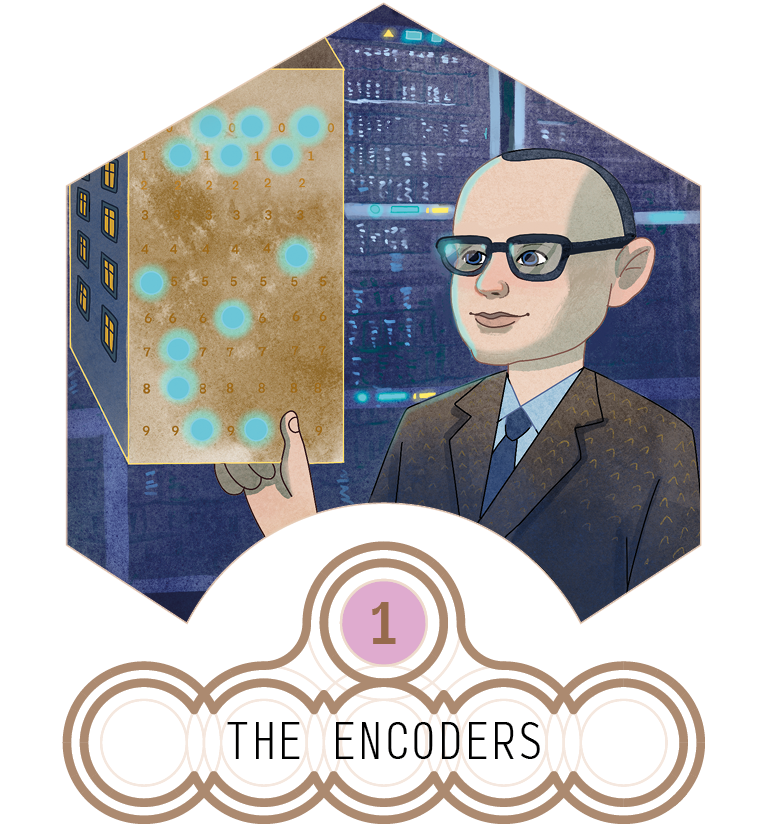
48°12‘41.5″N 16°22’26.9″E
48.211530, 16.374137
It had been one of those days, when nothing seemed to work. First, a “bug” had snuck into the code somewhere, and then, on his way home, he had gotten lost in the alleys of the first district.
He was standing in front of the Jerusalem staircase, about to ask a passer-by for directions, when Heinz noticed the wall to his right. Either he was slowly going mad or – in front of him was an overdimensioned punchcard.
Seemingly some buildings had been torn down and all that was left were 13 stubs on a white wall. They were the exact copy of an oversized punchcard, or at least that’s what his eyes led him to believe.
No, he hadn’t gone mad. Although if you’d asked his students, they would certainly have made a different assumption. Especially after his last lecture on the history of computers, when he talked about how he was one of the first people to build a transistor computer in Europe. And here, of all places, in dusty old Vienna. The computer was the size of four wardrobes and had neither a screen nor a mouse. It was programmed using punchcards, like the one he thought he was looking at right now. He had built the “Mailüfterl” (May breeze), as he called it, himself. From 3000 transistors and over 20,000 metres of switching wire. And he had done it because he could – and perhaps because no one had stopped him. At the time he had still been an assistant, and not a professor yet. Today, however, no one was trusted with that much freedom anymore, not even professors. Vienna was a city of magnificent buildings, and of all places, here on this corner in the first district, there was a building that reminded him of a punchcard and therefore of his Mailüfterl.
Those were the days, when they tried to find out if something had gone wrong with the programme via a radio. It went something like this: The calculation process had a certain rhythm. You could listen to that rhythm on a radio. If there was a continuous tone, they knew that something had gone wrong and the calculation process had to be started again the next day. “We monitored it back then, like a sick person in intensive care”, he thought to himself.
For programming they used the very tool that computer technology had taken from looms: the punchcard. Generally computers at that time were primarily people, and mostly women. A computer was a person who calculated things. But of course there were also people who worked with the first non-human computers. For example the ENIAC Girls, who programmed the first fully electronic computer in the USA in 1946. Or Kathleen Booth, who designed the first assembly language, the basic framework for easier communication with a computer. They were all people he admired enormously.
Heinz had to smile. From that day on, he loved to wander the alleys of the 1st district and visit his secret “punchcard”.
Until, one day, it was no longer possible for him to do so.
At first, the 13 stubs thought nothing of it. Their Heinz would surely still drop by towards the end of the week. But that was not the case. It became quiet around the Jerusalem staircase. No one paid any attention to the white wall, the little stubbles and no one saw them for what they really were: an oversized punchcard. It became gloomy around them. They had lost their identity. Black as night, a mist emanated from the ground. It sucked all the joy out of them. The “Grant” (grumpiness) had taken possession of them. The disease, which afflicts Viennese monsters when they are not paid enough attention.
The Grant had grown in size so much, that it almost threw zeN>.<Zen off her saddle as she whizzed past the Jerusalemstiege on her bicycle. She recognised the grey mist immediately. “Na servas”, she thought to herself, “I’ll have to tell Georgina about that right away!”.